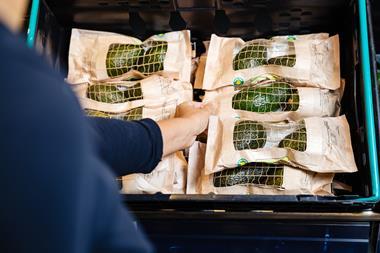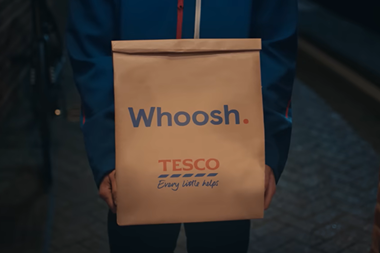Sainsbury’s Martin White is responsible for one of grocery’s most ambitious operational shake-ups. He talks with Elaine Watson
Trawl through the press cuttings on Sainsbury’s business transformation programme over the last 12 months and you’d be forgiven for thinking that Britain’s third largest grocer was heading for supply chain meltdown.
Indeed, the rumour mill had reached such a frenzy by late last year that a newspaper ran an article claiming, incorrectly, that Sainsbury had shut down Hams Hall - the automated RDC at the very centre of its new paperless supply chain project.
The article made interesting reading for those still working in the allegedly ‘closed’ depot, jokes Sainsbury’s supply chain director Martin White. But it was frustrating nonetheless. “It’s no secret that we have had some teething problems bedding in the new systems, but stories like that are not helpful,” he says.
As the man attempting to pull off one of the most ambitious operational overhauls in Europe at a time when Sainsbury cannot afford to take its eye off the ball, White has his work cut out.
Asda and Tesco don’t care if you are re-engineering your entire depot network and ripping out every IT system driving your business, he observes. They won’t cut you any slack - and neither will consumers.
The challenge, he says bluntly, is to learn how to use the powerful new tools at Sainsbury’s disposal “without screwing up the business in the meantime”.
Substantial progress has already been made. More than 60% of Sainsbury’s volumes now move through new automated distribution facilities; B2B platforms have been introduced to improve communications with suppliers; brand new EPoS systems have been rolled out across the estate and a new store replenishment system aimed at driving availability up and stock down is being rolled out.
Yet the tales of woe keep flooding in. One retail analyst says: “Where do I start? Refused deliveries at Hams Hall, problems with PKMS [the warehouse management system developed by Manhattan Associates], availability of less than 90% on perishables.”
The problem is not that Sainsbury has been too ambitious, he claims, but that it hasn’t executed its plans very well. “When some of the categories went live, it took four weeks for them to get things running smoothly - it’s just not good enough.” The fact that the depot replenishment system from Retek (see box below) will not be rolled out until 2006-7 would seem to make a mockery of Sir Peter Davis’ claims that new chief executive Justin King has the systems in place to “trade the business harder” he adds. “They are not even half-way through.”
White plays down the concerns, however. With a project of this scale, he says, teething problems were always anticipated. The press has simply blown them out of all proportion.
Poor supplier compliance with the “dependencies” required to service Sainsbury’s new automated fulfilment factories remain a continual source of frustration, however.
One of the main problems has been getting suppliers to deliver pallets and cases with accurate and readable barcodes that can be scanned when they arrive at the new depots. Similarly, the accuracy of data on electronic advance shipping notes has been “variable”. As the invoice is based on the ASN - that is, what Sainsbury actually receives from the supplier rather than what is on the purchase order - getting this right is critical. Yet only 65% of the ASNs Sainsbury receives are up to scratch, he says.
On-shelf availability, which some sources close to the company claim has been “appalling - beyond a joke” in some categories, is not yet where it could be, he concedes. “We had some availability blips in some categories as we installed the new systems and we had to build in some buffer stock. But they haven’t affected all products or all stores.”
In the latest ECR UK on-shelf availability survey, he adds, Sainsbury “certainly wasn’t bottom of the heap”.
The move to a paperless, and far more rigidly organised, backroom through a new hi-tech system from Retek should go a long way to tackle problems in the last 50 yards of the supply chain - a key cause of out of stocks, he says.
The shelf availability monitor tool, which tracks EPoS data on 2,000 lines every 15 minutes and compares it to the typical sales patterns for these items to identify anomalies, is another key weapon in the battle to drive availability, says White. However, Sainsbury is also about to hire an agency to do more on-shelf checks on a variety of slow as well as fast movers.
New B2B tools, including ECR scorecards and a collaborative performance management tool developed by online exchange GNX, are also helping to tackle availability issues, he says.
However, Sainsbury is not expecting technology to solve all its problems. “A lot of it isn’t rocket science, and things like making boxes that arrive at the back of the store more recognisable to staff is one example of how we can improve things,” says White. “I’m working in a store myself this week to see first hand what the issues are. There are a multitude of reasons why products aren’t on the shelves and there is no silver bullet.”
On the subject of RFID, he is much more cautious than rivals. “RFID isn’t going to solve our sales challenge. We trialled it four years ago and got the same kind of results that people are getting in trials now. We will look with interest at Wal-Mart and Tesco’s ability to roll this out. But I certainly don’t lie awake at night worrying that we will be left behind if we don’t start now.
“There is so much hype surrounding RFID that sometimes you get the feeling that it is a solution in search of a problem. We have other priorities at the moment. Being a fast follower rather than a pioneer is the right place to be.”
Plans to replace a raft of small depots with a few large, automated distribution centres are well advanced. Fulfilment factories at Hams Hall in Birmingham and Waltham Point in north London handle more than 1.3 million cases a week against a target of 2 million, while slow-moving depots at Rye Park and Stoke are also ramping up volumes according to plan, says White. Planning constraints are still thwarting progress at a site at Greenham Common, however. “We got such heavily caveated consent, that we are having to reconsider.”
Discussions with developers about a site in south London are progressing well.
CORE RELEASE 1 - First to go live in May 2003 was the Retek merchandising system (RMS), the heart and lungs of the replenishment system - a master file containing all the products and pricing information. On top of this sits the Retek demand forecasting store replenishment system (RDF) and the store replenishment system (SRP), which use a variety of inputs, from historical data to daily EPoS data and shelf life, and then work out what to order, by SKU, by store, per day.
This is being rolled out category by category and should be complete in the next couple of months, says Retek partner David Symonds. “This will allow Sainsbury to lower its instore stock levels, both on the shelf and the backroom.”
CORE RELEASE 2 - Retek Store System (RSS), which will be trialled in the summer and rolled out next year, aims to make the store backroom paperless.
RSS will allow staff to scan in rollcages via handheld terminals when they arrive at the back door and prioritise those with products that need to go straight on the shelf, says Symonds. It will also tell staff where to put products before they are needed on the shopfloor.
CORE RELEASE 3 - The final piece of the jigsaw, the cost accounting and depot replenishment planning system, will be introduced in 2006-2007. This is designed to generate the perfect order to suppliers, taking into account demand from stores, forecasts, and practical constraints such as how many pallets/cases fit on a truck, what delivery slots are available and supplier performance.
Sainsbury has also installed a host of IT applications from other vendors to tackle assortment planning, warehouse management, promotional planning and a range of supply chain functions.
Trawl through the press cuttings on Sainsbury’s business transformation programme over the last 12 months and you’d be forgiven for thinking that Britain’s third largest grocer was heading for supply chain meltdown.
Indeed, the rumour mill had reached such a frenzy by late last year that a newspaper ran an article claiming, incorrectly, that Sainsbury had shut down Hams Hall - the automated RDC at the very centre of its new paperless supply chain project.
The article made interesting reading for those still working in the allegedly ‘closed’ depot, jokes Sainsbury’s supply chain director Martin White. But it was frustrating nonetheless. “It’s no secret that we have had some teething problems bedding in the new systems, but stories like that are not helpful,” he says.
As the man attempting to pull off one of the most ambitious operational overhauls in Europe at a time when Sainsbury cannot afford to take its eye off the ball, White has his work cut out.
Asda and Tesco don’t care if you are re-engineering your entire depot network and ripping out every IT system driving your business, he observes. They won’t cut you any slack - and neither will consumers.
The challenge, he says bluntly, is to learn how to use the powerful new tools at Sainsbury’s disposal “without screwing up the business in the meantime”.
Substantial progress has already been made. More than 60% of Sainsbury’s volumes now move through new automated distribution facilities; B2B platforms have been introduced to improve communications with suppliers; brand new EPoS systems have been rolled out across the estate and a new store replenishment system aimed at driving availability up and stock down is being rolled out.
Yet the tales of woe keep flooding in. One retail analyst says: “Where do I start? Refused deliveries at Hams Hall, problems with PKMS [the warehouse management system developed by Manhattan Associates], availability of less than 90% on perishables.”
The problem is not that Sainsbury has been too ambitious, he claims, but that it hasn’t executed its plans very well. “When some of the categories went live, it took four weeks for them to get things running smoothly - it’s just not good enough.” The fact that the depot replenishment system from Retek (see box below) will not be rolled out until 2006-7 would seem to make a mockery of Sir Peter Davis’ claims that new chief executive Justin King has the systems in place to “trade the business harder” he adds. “They are not even half-way through.”
White plays down the concerns, however. With a project of this scale, he says, teething problems were always anticipated. The press has simply blown them out of all proportion.
Poor supplier compliance with the “dependencies” required to service Sainsbury’s new automated fulfilment factories remain a continual source of frustration, however.
One of the main problems has been getting suppliers to deliver pallets and cases with accurate and readable barcodes that can be scanned when they arrive at the new depots. Similarly, the accuracy of data on electronic advance shipping notes has been “variable”. As the invoice is based on the ASN - that is, what Sainsbury actually receives from the supplier rather than what is on the purchase order - getting this right is critical. Yet only 65% of the ASNs Sainsbury receives are up to scratch, he says.
On-shelf availability, which some sources close to the company claim has been “appalling - beyond a joke” in some categories, is not yet where it could be, he concedes. “We had some availability blips in some categories as we installed the new systems and we had to build in some buffer stock. But they haven’t affected all products or all stores.”
In the latest ECR UK on-shelf availability survey, he adds, Sainsbury “certainly wasn’t bottom of the heap”.
The move to a paperless, and far more rigidly organised, backroom through a new hi-tech system from Retek should go a long way to tackle problems in the last 50 yards of the supply chain - a key cause of out of stocks, he says.
The shelf availability monitor tool, which tracks EPoS data on 2,000 lines every 15 minutes and compares it to the typical sales patterns for these items to identify anomalies, is another key weapon in the battle to drive availability, says White. However, Sainsbury is also about to hire an agency to do more on-shelf checks on a variety of slow as well as fast movers.
New B2B tools, including ECR scorecards and a collaborative performance management tool developed by online exchange GNX, are also helping to tackle availability issues, he says.
However, Sainsbury is not expecting technology to solve all its problems. “A lot of it isn’t rocket science, and things like making boxes that arrive at the back of the store more recognisable to staff is one example of how we can improve things,” says White. “I’m working in a store myself this week to see first hand what the issues are. There are a multitude of reasons why products aren’t on the shelves and there is no silver bullet.”
On the subject of RFID, he is much more cautious than rivals. “RFID isn’t going to solve our sales challenge. We trialled it four years ago and got the same kind of results that people are getting in trials now. We will look with interest at Wal-Mart and Tesco’s ability to roll this out. But I certainly don’t lie awake at night worrying that we will be left behind if we don’t start now.
“There is so much hype surrounding RFID that sometimes you get the feeling that it is a solution in search of a problem. We have other priorities at the moment. Being a fast follower rather than a pioneer is the right place to be.”
Plans to replace a raft of small depots with a few large, automated distribution centres are well advanced. Fulfilment factories at Hams Hall in Birmingham and Waltham Point in north London handle more than 1.3 million cases a week against a target of 2 million, while slow-moving depots at Rye Park and Stoke are also ramping up volumes according to plan, says White. Planning constraints are still thwarting progress at a site at Greenham Common, however. “We got such heavily caveated consent, that we are having to reconsider.”
Discussions with developers about a site in south London are progressing well.
CORE RELEASE 1 - First to go live in May 2003 was the Retek merchandising system (RMS), the heart and lungs of the replenishment system - a master file containing all the products and pricing information. On top of this sits the Retek demand forecasting store replenishment system (RDF) and the store replenishment system (SRP), which use a variety of inputs, from historical data to daily EPoS data and shelf life, and then work out what to order, by SKU, by store, per day.
This is being rolled out category by category and should be complete in the next couple of months, says Retek partner David Symonds. “This will allow Sainsbury to lower its instore stock levels, both on the shelf and the backroom.”
CORE RELEASE 2 - Retek Store System (RSS), which will be trialled in the summer and rolled out next year, aims to make the store backroom paperless.
RSS will allow staff to scan in rollcages via handheld terminals when they arrive at the back door and prioritise those with products that need to go straight on the shelf, says Symonds. It will also tell staff where to put products before they are needed on the shopfloor.
CORE RELEASE 3 - The final piece of the jigsaw, the cost accounting and depot replenishment planning system, will be introduced in 2006-2007. This is designed to generate the perfect order to suppliers, taking into account demand from stores, forecasts, and practical constraints such as how many pallets/cases fit on a truck, what delivery slots are available and supplier performance.
Sainsbury has also installed a host of IT applications from other vendors to tackle assortment planning, warehouse management, promotional planning and a range of supply chain functions.
















No comments yet